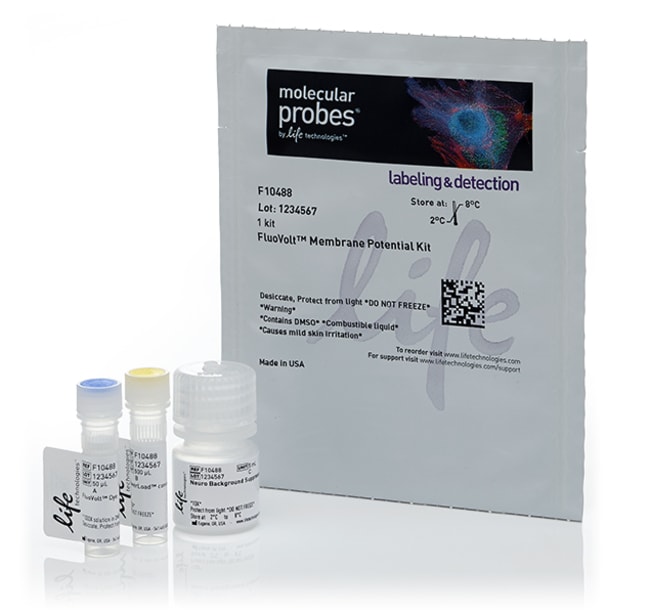Search Thermo Fisher Scientific

Catalog Number
F10488
Unit Size
1 kit
Price (EUR)
716,00
Availability
-
Quantity
| Catalog Number | Unit Size | Price (EUR) | Availability | Quantity | |
|---|---|---|---|---|---|
| F10488 | 1 kit | 716,00 | - |
Product Overview
Figures
Videos
Recommendations
Recommendations
Documents
FAQ
Citations & References
Additional Information
Recommendations
The FluoVolt™ Membrane Potential Kit represents the next generation in voltage sensitive fluorescent probe-based kits. The FluoVolt™ probe brings together the best characteristics of the fast and slow response membrane potential fluorescent probes. The FluoVolt™ probe responds to changes in membrane potential in sub-milliseconds and displays a high magnitude of response.
Learn more about ion indicators including calcium, potassium, pH, and membrane potential indicators ›
Features of the FluoVolt™ Membrane Potential Probe include:
• Fast—responds to changes in membrane potential within sub-milliseconds
• High sensitivity—response range is typically 25% per 100 mV
• Emission/excitation works with standard FITC settings
• Can be used in imaging or patch clamp applications
Changes in membrane potential play a central role in many physiological processes, including nerve-impulse propagation, muscle contraction, and cell signaling. Potentiometric fluorescent probes are important tools for studying these processes and are generally characterized as slow- or fast-response probes.
The Best Characteristics of Slow- and Fast-Response Probes
Slow-response probes function by entering depolarized cells, binding to proteins or membranes, and exhibiting enhanced fluorescence. This membrane translocation event decreases the ability of these reporters to respond to changes in membrane potential and introduces a capacitive load that can affect cell health. However, these probes display a high magnitude of response; typically in the 1% per mV range.
Fast-response probes are molecules that change their structure in response to the surrounding electric field and detect transient (millisecond) potential changes. However, when compared to the slow-response probes, the fast-response probes have a magnitude of potential-dependent fluorescence change that is often small (2–10% fluorescence change per 100 mV).
The FluoVolt™ Membrane Potential Probe displays the best properties of the slow- and fast-response probes. The FluoVolt™ probe is a fast-response probe with a superior potential-dependent fluorescence response. The response is fast enough to detect transient (sub-millisecond) potential changes in excitable cells and generates a signal change in excess of 25% per 100 mV.
PowerLoad™ and Background Suppressor Solutions Also Included
For easy cell loading, the FluoVolt™ Membrane Potential Kit contains PowerLoad™ Concentrate. Due to the unique nature of the PowerLoad™ solution, it can be used in the presence of complete culture media, thus reducing the negative effects of replacing media or loading in serum-free media.
Baseline autofluorescence caused by components within growth media can be greatly reduced by the addition of the included Neuro Background Supressor. This solution has been specifically formulated for use with neuronal cells and will not cause osmotic shock. Additionally, the Neuro Background Suppressor has been used successfully with many different cell types to efficiently suppress background fluorescence without sacrificing the specific cellular fluorescence generated in the assay.
Learn more about ion indicators including calcium, potassium, pH, and membrane potential indicators ›
Features of the FluoVolt™ Membrane Potential Probe include:
• Fast—responds to changes in membrane potential within sub-milliseconds
• High sensitivity—response range is typically 25% per 100 mV
• Emission/excitation works with standard FITC settings
• Can be used in imaging or patch clamp applications
Changes in membrane potential play a central role in many physiological processes, including nerve-impulse propagation, muscle contraction, and cell signaling. Potentiometric fluorescent probes are important tools for studying these processes and are generally characterized as slow- or fast-response probes.
The Best Characteristics of Slow- and Fast-Response Probes
Slow-response probes function by entering depolarized cells, binding to proteins or membranes, and exhibiting enhanced fluorescence. This membrane translocation event decreases the ability of these reporters to respond to changes in membrane potential and introduces a capacitive load that can affect cell health. However, these probes display a high magnitude of response; typically in the 1% per mV range.
Fast-response probes are molecules that change their structure in response to the surrounding electric field and detect transient (millisecond) potential changes. However, when compared to the slow-response probes, the fast-response probes have a magnitude of potential-dependent fluorescence change that is often small (2–10% fluorescence change per 100 mV).
The FluoVolt™ Membrane Potential Probe displays the best properties of the slow- and fast-response probes. The FluoVolt™ probe is a fast-response probe with a superior potential-dependent fluorescence response. The response is fast enough to detect transient (sub-millisecond) potential changes in excitable cells and generates a signal change in excess of 25% per 100 mV.
PowerLoad™ and Background Suppressor Solutions Also Included
For easy cell loading, the FluoVolt™ Membrane Potential Kit contains PowerLoad™ Concentrate. Due to the unique nature of the PowerLoad™ solution, it can be used in the presence of complete culture media, thus reducing the negative effects of replacing media or loading in serum-free media.
Baseline autofluorescence caused by components within growth media can be greatly reduced by the addition of the included Neuro Background Supressor. This solution has been specifically formulated for use with neuronal cells and will not cause osmotic shock. Additionally, the Neuro Background Suppressor has been used successfully with many different cell types to efficiently suppress background fluorescence without sacrificing the specific cellular fluorescence generated in the assay.
For Research Use Only. Not for use in diagnostic procedures.
Specifications
Product Type
Stain
Product Line
Molecular Probes™
Sub Cellular Localization
Cell Membranes & Lipids
Contents & Storage
Contains: 50 μL of FluoVolt™ Dye 500 μL of PowerLoad™ Concentrate 5 mL of Neuro Background Suppressor Store at 2°C to 8°C Do not freeze
Figures
Documents & Downloads
Certificates
Search by lot number or partial lot number
Frequently asked questions (FAQs)
Citations & References
Search citations by name, author, journal title or abstract text